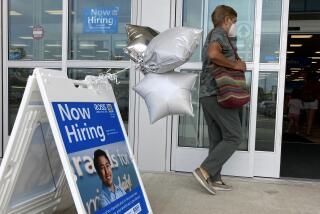Reports Point to Slow but Sustained Recovery : Economy: Leading indicators and factory orders gain while new unemployment applications fall.
- Share via
WASHINGTON — Three encouraging new economic reports on Thursday flashed a green light for slow but sustained recovery from the recession this year.
The government’s chief forecasting gauge climbed for the third straight month in March. New applications for unemployment benefits in late April held at the lowest level since last October. And orders to factories in March rose strongly.
“The statistics all point in the same direction,” said economist David Jones of Aubrey G. Lanston & Co., a New York securities dealer. “We have indeed started a moderate recovery. It will be slower and more uneven than a normal recovery. . . . But all in all, I think we’re looking at the foundation for a sustainable recovery.”
The Commerce Department’s index of leading indicators increased 0.2% in March after strong gains of 0.8% in February and 1% in January.
Although the latest advance was small, the first quarter marked the first time since May through July of last year that the index moved higher during three consecutive months.
The 1.6% rise in orders to U.S. factories was stronger than anticipated by most analysts. It was pulled up by a 2.1% gain in orders for durable goods, such as automobiles and furniture.
However, the backlog of unfilled orders at factories fell 0.6%, the seventh drop in a row. That shows the current manufacturing work force is keeping up with rising demand and factory managers probably aren’t yet feeling pressured to expand their payrolls.
Judging by the number of applications for unemployment benefits, manufacturing companies and other employers are laying off fewer workers. But the economic upturn isn’t strong enough yet to encourage a hiring boom.
The Labor Department said the number of Americans filing first-time claims for unemployment insurance was unchanged during the week ending April 18 at a six-month low of 404,000. Claims had dropped significantly during the three previous weeks.
“The economy’s not hitting on all cylinders, but at least the engine’s running,” said economist Paul Lally of R. H. Wrightson & Associates in New York.
The most important of four indicators supporting the gain in the leading index was a substantial improvement in consumer optimism. It more than offset the most substantial of six negative indicators, a drop in the inflation-adjusted money supply.
Treasury Secretary Nicholas F. Brady praised the Federal Reserve for trying to stimulate money supply growth, and thus economic growth, by cutting a key short-term interest rate three weeks ago. But, Brady cautioned the central bank to remain vigilant.
“If the growth of the money supply were to stagnate in the spring or summer of ’92 as it did in the spring and summer of ‘91, the recovery would be threatened and an opportunity lost,” he told the Republican Task Force on Tax Policy and Job Creation, a congressional group.
The Bush Administration is counting on faster growth through November to bolster the President’s reelection chances. Bush’s advisers have complained that Federal Reserve timidity in cutting rates last year ruined the prospects for a fast recovery from the recession that began in July, 1990.
During the first three months of this year, the economy expanded at a modest 2% annual rate. Most analysts believe growth will accelerate to the 3% range during the second half of the year.
Still, that would not be enough to bring substantial improvement in the nation’s unemployment rate, which remained stuck at a 6 1/2-year high of 7.3% in March.
The other positive indicators in the leading index were a rise in prices for sensitive industrial materials, considered a sign of stronger demand; an increase in orders for new business equipment and buildings, and slower deliveries by goods-producing industries, another sign of strengthened demand.
The other negatives were building permits, orders to factories for consumer goods, manufacturers’ backlog of unfilled orders, stock prices and new claims for unemployment insurance, which were up on average in March before starting their most recent decline.
The average workweek held steady during the month.
The various changes left the index at 147.9% of its 1982 base. The index has risen 1.9% during the first quarter compared to a 0.3% decline during the fourth quarter.
Index of Leading Indicators
Seasonally adjusted index, 1982=100
March, ‘92: 147.9
Feb., ‘92: 147.6
March, ‘91: 141.5 Source: Commerce Department
Factory Orders
Total new orders in billions of dollars, seasonally adjusted
March, ‘92: 240.8
Feb., ‘92: 236.9
March, ‘91: 226.4 Source: Commerce Department
More to Read
Inside the business of entertainment
The Wide Shot brings you news, analysis and insights on everything from streaming wars to production — and what it all means for the future.
You may occasionally receive promotional content from the Los Angeles Times.










